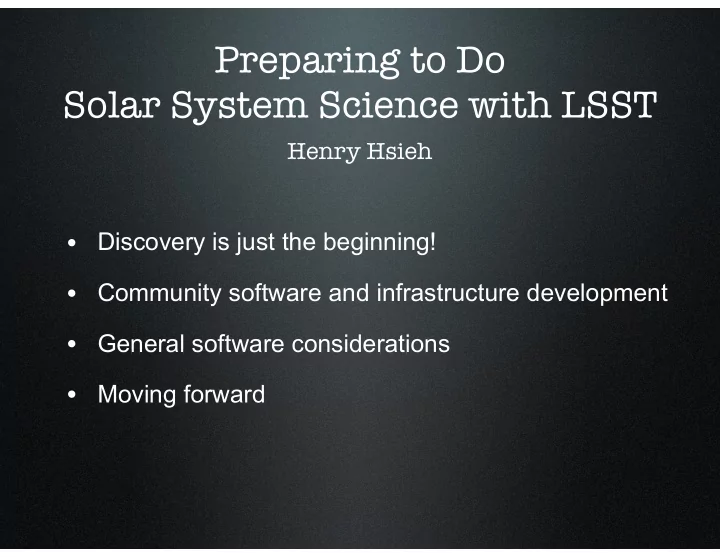

Preparing to Do Solar System Science with LSST Henry Hsieh • Discovery is just the beginning! • Community software and infrastructure development • General software considerations • Moving forward
Discovery is just the beginning! • Things that LSST/MOPS will provide: - astrometry, photometry, basic morphology - orbital elements - best-fit H,G 12 phase function parameters - orbital/observing geometry parameters (hopefully) - multi-aperture photometry (hopefully) • Things that the SSSC or individual users will need to measure/derive/produce: - best-fit parameters for other phase function models - colors and taxonomic classifications - rotation rates, shape parameters, pole orientations - proper elements, family associations, resonant object identification - advanced activity detection parameters - activity characterization parameters - forced photometry for solar system objects - tools for debiasing survey results - ...and many others!
Community Software and Infrastructure Development
General Software Considerations • Goal is to minimize redundant efforts - By combining efforts, can investigate more interesting problems - Producing higher-order data products will also lower barriers to data use (e.g., NEOWISE albedos) • Desired time-scale for processing - Highly time-sensitive (immediate/daily): e.g., activity detection - Moderately time-sensitive (monthly): e.g., phase function determination - Low time-sensitivity (yearly): e.g., family association identification • Is image data required? - Ideally would determine common image needs and run multiple analyses on single retrieved images • How to prioritize? - Probably best to use combination of importance to high-priority science goals and consideration of inter-dependencies of different software tools
General Software Considerations • Need ability to derive data products from time-constrained data sets to study changes in physical/dynamical properties - e.g., studying color changes after disruption events - e.g., studying rotation rate changes in comets during perihelion passages • Determining properties for objects with sub-optimal data sets - e.g., "single-filter" phase functions by assuming colors - e.g., color determination from linear phase functions - e.g., somehow incorporating data from follow-up observations • For alerts to account for user-generated products, SSSC will (probably) need its own alert system
Moving Forward • Software development white papers - Software development task roadmap/prioritization -- M. Schwamb - Detailed discussion of software development tasks -- H. Hsieh - Contact authors to get involved • Funding proposals - Belfast group has been funded for LSST work for a number of years now - NSF is obvious target, but could also pursue NASA funding - Deadline for "no-deadline" SPG NSF proposals at end of September; otherwise all proposals will revert to Nov 15 deadline this year - Many scientists need salary support; also travel support to attend PCWs - Discussion at Solar System Sprint included pushing for NASA support at upcoming SBAG meeting - Plans to also lay groundwork by publishing software/cadence white papers • Many test data sets currently available - e.g., ZTF, ATLAS, DECam
Recommend
More recommend